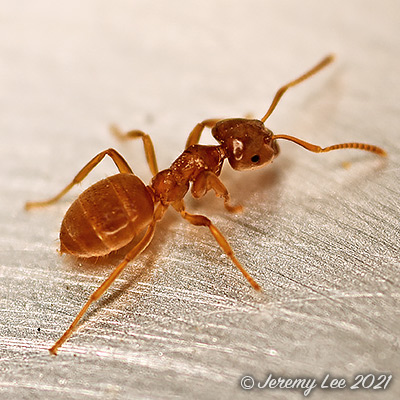
 |
|
Scientific Classifications explained » Amphibians » Ants » Aphids » Bees » Beetles » Birds » Bugs » Butterflies » Caterpillars » Damselflies » Dragonflies » Earwigs » Flies » Frog/Leafhoppers » Fungi » Galls » Grasshoppers » Harvestmen » Hoverflies » Lacewings » Ladybirds » Leaf Mines » Lichens » Mammals » Millipedes » Mosses » Moths » Sawflies » Slugs » Snails » Spiders » Trees & Shrubs » Wasps » Wild Flowers » Woodlice » Postboxes |
UK Nature > Ants > Lasius flavus

Scientific Name: Lasius flavus Common Name: Yellow Meadow Ant Lasius flavus, more commonly known as the Yellow Meadow Ant, is one of the most common ants in the UK. The queen is 7–9 mm long, males 3–4 mm and workers 2–4 mm. Their colour varies from yellow to brown, with queen and males being slightly more darkly colored. The species lives primarily underground in meadows and very commonly, lawns. The nests are often completely overgrown by grass, however, often their presence is betrayed by small mounds of loose soil material between the grass stalks. They will also nest under large rocks or concrete slabs. Lawn nesting will eventually become obvious as the aphids clear sections of grass or portions of gardens. The yellow meadow ant feeds on the honeydew from root aphids, which they breed in their nests. During winter, the aphids themselves are sometimes eaten. As a consequence of their feeding habits, the species only occasionally forages outside the nest. Evidence of their underground lives is their lack of pigmentation and the smaller size of their eyes, compared to closely related species like the black garden ant. They are a timid species and will often simply barricade their tunnels to fight off invaders. |
|

https://www.uknature.co.uk is a website dedicated to showing the immense diversity of UK nature and wildlife. Our vast range of habitats, from lowland arable to snow covered mountains, from storm-ravaged coastlines to peaceful inland freshwater lakes and rivers, from dry, sandy heaths to deciduous and coniferous forests, all these habitats contribute to the abundance of UK nature. We have wild birds in huge numbers either residing or visiting our shores (597 recorded species as at July 2013) and we must also not forget the humble back garden with its grass lawns, flower beds filled with nectar rich flowers, shrubs and trees, all designed to attract huge numbers of insects such as bees, moths, butterflies and hoverflies; and finally the small ponds which provide safe havens for frogs, toads, newts and even slow worms and grass snakes. www.uknature.co.uk is the showcase for my personal passion, photographing uknature in all its glory. I sincerely hope you all enjoy the fruits of my labours. This site and all images contained therein is © Jeremy Lee 2004 - 2025. All Rights Reserved. Site design by Jeremy Lee. Site development & IT Support by Stuart Lee. |